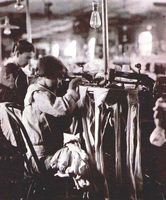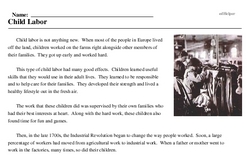Child Labor
Child labor is not anything new. When most of the people in Europe lived off the land, children worked on the farms right alongside other members of their families. They got up early and worked hard.
This type of child labor had many good effects. Children learned useful skills that they would use in their adult lives. They learned to be responsible and to help care for their families. They developed their strength and lived a healthy lifestyle out in the fresh air.
The work that these children did was supervised by their own families who had their best interests at heart. Along with the hard work, these children also found time for fun and games.
Then, in the late 1700s, the Industrial Revolution began to change the way people worked. Soon, a large percentage of workers had moved from agricultural work to industrial work. When a father or mother went to work in the factories, many times, so did their children.
This factory work was hard on everyone - men, women, and children - but no one felt the bad effects of the Industrial Revolution more than its youngest workers, the children who labored in the factories.
The workday for a child in a textile factory might begin at 5:00 A. M. with a quick breakfast of porridge and a mile-long walk to the factory.
In the factory, the youngest children, those around six years old, were given the job of scavenger. The scavenger's job was to pick up the loose cotton that accumulated under the machines. They did their work crouched down low under the operating machinery.
Children who had some experience working in the factory were given the job of piecer. A piecer's job was to catch broken threads and tie them back together. Piecers walked miles every day as they moved up and down the rows looking for broken threads and leaned over the machines to tie them.




